
It’s built for real-time applications and use cases where milliseconds matter, and budgets are tight—yet you still want a taste of OpenAI-grade intelligence.
- Mobile & Edge App Developers: Run lightweight NLP directly on devices with blazing speed.
- High-Volume Platform Builders: Use for millions of low-cost interactions without sacrificing quality.
- Customer Support Teams: Build fast, scalable bots for quick resolutions and user triaging.
- SaaS Companies: Add efficient autocomplete, summarization, or Q&A without breaking the bank.
- IoT & Embedded Systems: Deploy conversational AI in devices where size and speed matter most.
- Startups & Hackers: Experiment affordably with a capable GPT-based model in MVPs or prototypes.
🛠️ How to Use GPT-4.1 Nano?
- Step 1: Get API Access: Log into your OpenAI developer account and select gpt-4.1-nano from the model list.
- Step 2: Prepare Your Input Prompt: Keep prompts short and focused. Nano thrives in low-context, straightforward queries.
- Step 3: Make Your API Call: Use gpt-4.1-nano as the model parameter, fine-tune temperature and top_p as needed.
- Step 4: Handle Responses in Real-Time: Designed for latency-sensitive applications, it’s great for quick user-facing tasks.
- Step 5: Iterate & Optimize: Pair with logging and A/B testing to continuously improve prompt and UX quality.
- Ultra-Low Latency: Built for instant responses—ideal for real-time products.
- Minimal Compute Cost: Extremely affordable for high-frequency or large-scale usage.
- Small but Mighty: Delivers competent NLP for classification, summarization, and basic Q&A.
- Perfect for Edge & Mobile: Small footprint allows for use in constrained environments.
- Part of GPT-4.1 Family: Leverages core advances from the broader GPT-4.1 architecture.
- API Ready: Fully integrated into OpenAI’s API for simple deployment at scale.
- Blazing Fast: Almost instantaneous results for text tasks.
- Ridiculously Cheap: Ideal when every penny counts.
- Smart Enough for Simple Stuff: Handles many common NLP needs effectively.
- Great for Mobile & Embedded: A real option for on-device intelligence.
- Perfect for Scaling: Deploy at massive volumes with minimal cost stress.
- Very Short Context Window: Poor at handling longer conversations or tasks.
- Limited Depth of Reasoning: Don’t expect it to write you a thesis or solve a puzzle.
- Not Ideal for Complex Prompts: May need simpler, more structured inputs.
- No Advanced Tools: Doesn’t support browsing, code interpreter, or function calling.
- Lower Output Richness: Lacks the richness and nuance of larger GPT-4 models.
API Only
$0.1/$0.4 for 1M tokens
Proud of the love you're getting? Show off your AI Toolbook reviews—then invite more fans to share the love and build your credibility.
Add an AI Toolbook badge to your site—an easy way to drive followers, showcase updates, and collect reviews. It's like a mini 24/7 billboard for your AI.
Reviews
Rating Distribution
Average score
Popular Mention
FAQs
Similar AI Tools

OpenAI’s Real-Time API is a game-changing advancement in AI interaction, enabling developers to build apps that respond instantly—literally in milliseconds—to user inputs. It drastically reduces the response latency of OpenAI’s GPT-4o model to as low as 100 milliseconds, unlocking a whole new world of AI-powered experiences that feel more human, responsive, and conversational in real time. Whether you're building a live voice assistant, a responsive chatbot, or interactive multiplayer tools powered by AI, this API puts real in real-time AI.


OpenAI Realtime AP..
OpenAI’s Real-Time API is a game-changing advancement in AI interaction, enabling developers to build apps that respond instantly—literally in milliseconds—to user inputs. It drastically reduces the response latency of OpenAI’s GPT-4o model to as low as 100 milliseconds, unlocking a whole new world of AI-powered experiences that feel more human, responsive, and conversational in real time. Whether you're building a live voice assistant, a responsive chatbot, or interactive multiplayer tools powered by AI, this API puts real in real-time AI.


OpenAI Realtime AP..
OpenAI’s Real-Time API is a game-changing advancement in AI interaction, enabling developers to build apps that respond instantly—literally in milliseconds—to user inputs. It drastically reduces the response latency of OpenAI’s GPT-4o model to as low as 100 milliseconds, unlocking a whole new world of AI-powered experiences that feel more human, responsive, and conversational in real time. Whether you're building a live voice assistant, a responsive chatbot, or interactive multiplayer tools powered by AI, this API puts real in real-time AI.


OpenAI o3
o3 is OpenAI's next-generation language model, representing a significant leap in performance, reasoning ability, and efficiency. Positioned between GPT-4 and GPT-4o in terms of evolution, o3 is engineered for advanced language understanding, content generation, multilingual communication, and code-related tasks—while maintaining faster speeds and lower latency than earlier models. As part of OpenAI’s GPT-4 Turbo family, o3 delivers high-quality outputs at scale, supporting both chat and completion endpoints. It’s currently used in various commercial and developer-facing tools for streamlined and intelligent interactions.


OpenAI o3
o3 is OpenAI's next-generation language model, representing a significant leap in performance, reasoning ability, and efficiency. Positioned between GPT-4 and GPT-4o in terms of evolution, o3 is engineered for advanced language understanding, content generation, multilingual communication, and code-related tasks—while maintaining faster speeds and lower latency than earlier models. As part of OpenAI’s GPT-4 Turbo family, o3 delivers high-quality outputs at scale, supporting both chat and completion endpoints. It’s currently used in various commercial and developer-facing tools for streamlined and intelligent interactions.


OpenAI o3
o3 is OpenAI's next-generation language model, representing a significant leap in performance, reasoning ability, and efficiency. Positioned between GPT-4 and GPT-4o in terms of evolution, o3 is engineered for advanced language understanding, content generation, multilingual communication, and code-related tasks—while maintaining faster speeds and lower latency than earlier models. As part of OpenAI’s GPT-4 Turbo family, o3 delivers high-quality outputs at scale, supporting both chat and completion endpoints. It’s currently used in various commercial and developer-facing tools for streamlined and intelligent interactions.


OpenAI o1-pro
o1-pro is a highly capable AI model developed by OpenAI, designed to deliver efficient, high-quality text generation across a wide range of use cases. As part of OpenAI’s GPT-4 architecture family, o1-pro is optimized for low-latency performance and high accuracy—making it suitable for both everyday tasks and enterprise-scale applications. It powers natural language interactions, content creation, summarization, and more, offering developers a solid balance between performance, cost, and output quality.


OpenAI o1-pro
o1-pro is a highly capable AI model developed by OpenAI, designed to deliver efficient, high-quality text generation across a wide range of use cases. As part of OpenAI’s GPT-4 architecture family, o1-pro is optimized for low-latency performance and high accuracy—making it suitable for both everyday tasks and enterprise-scale applications. It powers natural language interactions, content creation, summarization, and more, offering developers a solid balance between performance, cost, and output quality.


OpenAI o1-pro
o1-pro is a highly capable AI model developed by OpenAI, designed to deliver efficient, high-quality text generation across a wide range of use cases. As part of OpenAI’s GPT-4 architecture family, o1-pro is optimized for low-latency performance and high accuracy—making it suitable for both everyday tasks and enterprise-scale applications. It powers natural language interactions, content creation, summarization, and more, offering developers a solid balance between performance, cost, and output quality.


OpenAI GPT 4o Sear..
GPT-4o Search Preview is a powerful experimental feature of OpenAI’s GPT-4o model, designed to act as a high-performance retrieval system. Rather than just generating answers from training data, it allows the model to search through large datasets, documents, or knowledge bases to surface relevant results with context-aware accuracy. Think of it as your AI assistant with built-in research superpowers—faster, smarter, and surprisingly precise. This preview gives developers a taste of what’s coming next: an intelligent search engine built directly into the GPT-4o ecosystem.


OpenAI GPT 4o Sear..
GPT-4o Search Preview is a powerful experimental feature of OpenAI’s GPT-4o model, designed to act as a high-performance retrieval system. Rather than just generating answers from training data, it allows the model to search through large datasets, documents, or knowledge bases to surface relevant results with context-aware accuracy. Think of it as your AI assistant with built-in research superpowers—faster, smarter, and surprisingly precise. This preview gives developers a taste of what’s coming next: an intelligent search engine built directly into the GPT-4o ecosystem.


OpenAI GPT 4o Sear..
GPT-4o Search Preview is a powerful experimental feature of OpenAI’s GPT-4o model, designed to act as a high-performance retrieval system. Rather than just generating answers from training data, it allows the model to search through large datasets, documents, or knowledge bases to surface relevant results with context-aware accuracy. Think of it as your AI assistant with built-in research superpowers—faster, smarter, and surprisingly precise. This preview gives developers a taste of what’s coming next: an intelligent search engine built directly into the GPT-4o ecosystem.


OpenAI GPT 4o mini..
GPT-4o-mini Search Preview is OpenAI’s lightweight semantic search feature powered by the GPT-4o-mini model. Designed for real-time applications and low-latency environments, it brings retrieval-augmented intelligence to any product or tool that needs blazing-fast, accurate information lookup. While compact in size, it offers the power of contextual understanding, enabling smarter, more relevant search results with fewer resources. It’s ideal for startups, embedded systems, or anyone who needs search that just works—fast, efficient, and tuned for integration.


OpenAI GPT 4o mini..
GPT-4o-mini Search Preview is OpenAI’s lightweight semantic search feature powered by the GPT-4o-mini model. Designed for real-time applications and low-latency environments, it brings retrieval-augmented intelligence to any product or tool that needs blazing-fast, accurate information lookup. While compact in size, it offers the power of contextual understanding, enabling smarter, more relevant search results with fewer resources. It’s ideal for startups, embedded systems, or anyone who needs search that just works—fast, efficient, and tuned for integration.


OpenAI GPT 4o mini..
GPT-4o-mini Search Preview is OpenAI’s lightweight semantic search feature powered by the GPT-4o-mini model. Designed for real-time applications and low-latency environments, it brings retrieval-augmented intelligence to any product or tool that needs blazing-fast, accurate information lookup. While compact in size, it offers the power of contextual understanding, enabling smarter, more relevant search results with fewer resources. It’s ideal for startups, embedded systems, or anyone who needs search that just works—fast, efficient, and tuned for integration.


OpenAI Codex mini ..
codex-mini-latest is OpenAI’s lightweight, high-speed AI coding model, fine-tuned from the o4-mini architecture. Designed specifically for use with the Codex CLI, it brings ChatGPT-level reasoning directly to your terminal, enabling efficient code generation, debugging, and editing tasks. Despite its compact size, codex-mini-latest delivers impressive performance, making it ideal for developers seeking a fast, cost-effective coding assistant.


OpenAI Codex mini ..
codex-mini-latest is OpenAI’s lightweight, high-speed AI coding model, fine-tuned from the o4-mini architecture. Designed specifically for use with the Codex CLI, it brings ChatGPT-level reasoning directly to your terminal, enabling efficient code generation, debugging, and editing tasks. Despite its compact size, codex-mini-latest delivers impressive performance, making it ideal for developers seeking a fast, cost-effective coding assistant.


OpenAI Codex mini ..
codex-mini-latest is OpenAI’s lightweight, high-speed AI coding model, fine-tuned from the o4-mini architecture. Designed specifically for use with the Codex CLI, it brings ChatGPT-level reasoning directly to your terminal, enabling efficient code generation, debugging, and editing tasks. Despite its compact size, codex-mini-latest delivers impressive performance, making it ideal for developers seeking a fast, cost-effective coding assistant.
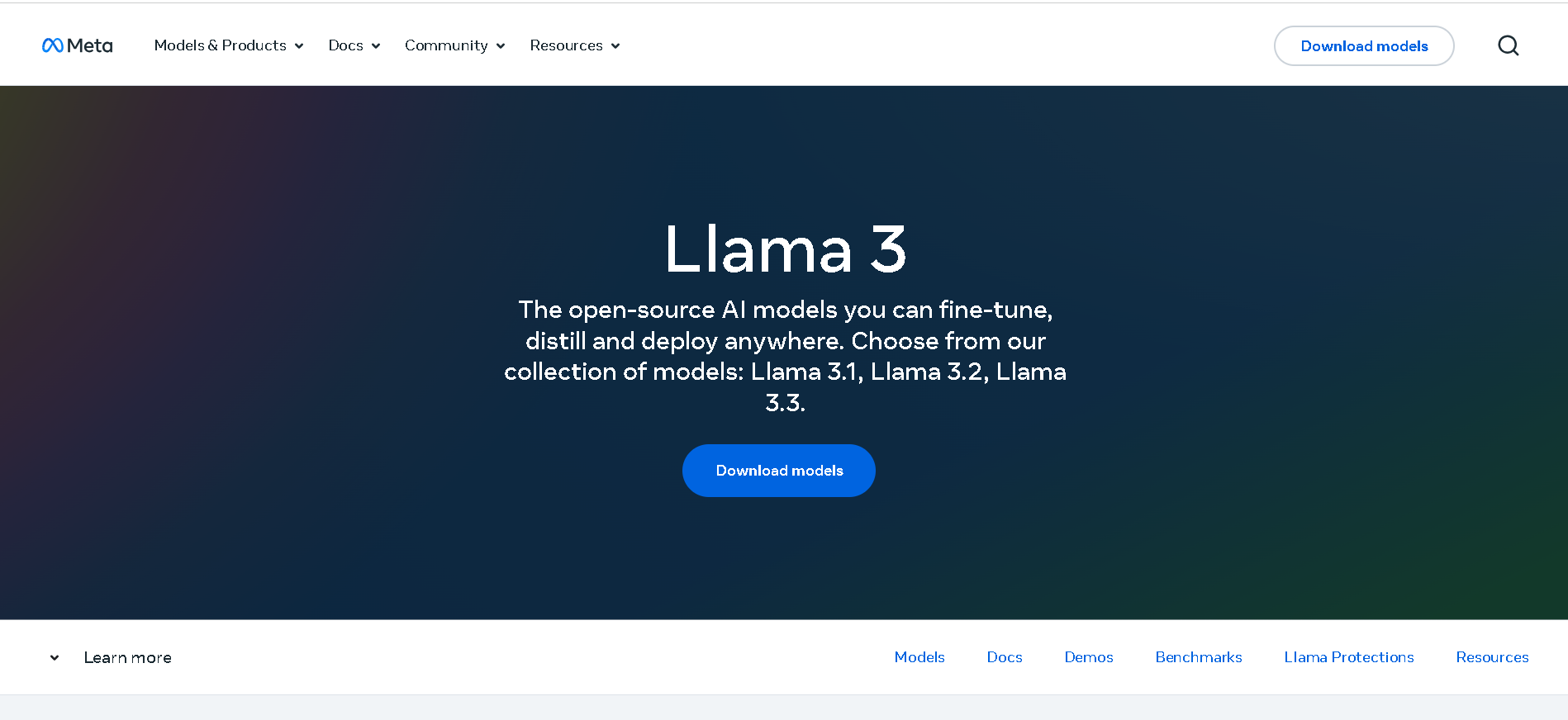

Meta Llama 3
Meta Llama 3 is Meta’s third-generation open-weight large language model family, released in April 2024 and enhanced in July 2024 with the 3.1 update. It spans three sizes—8B, 70B, and 405B parameters—each offering a 128K‑token context window. Llama 3 excels at reasoning, code generation, multilingual text, and instruction-following, and introduces multimodal vision (image understanding) capabilities in its 3.2 series. Robust safety mechanisms like Llama Guard 3, Code Shield, and CyberSec Eval 2 ensure responsible output.


Meta Llama 3
Meta Llama 3 is Meta’s third-generation open-weight large language model family, released in April 2024 and enhanced in July 2024 with the 3.1 update. It spans three sizes—8B, 70B, and 405B parameters—each offering a 128K‑token context window. Llama 3 excels at reasoning, code generation, multilingual text, and instruction-following, and introduces multimodal vision (image understanding) capabilities in its 3.2 series. Robust safety mechanisms like Llama Guard 3, Code Shield, and CyberSec Eval 2 ensure responsible output.


Meta Llama 3
Meta Llama 3 is Meta’s third-generation open-weight large language model family, released in April 2024 and enhanced in July 2024 with the 3.1 update. It spans three sizes—8B, 70B, and 405B parameters—each offering a 128K‑token context window. Llama 3 excels at reasoning, code generation, multilingual text, and instruction-following, and introduces multimodal vision (image understanding) capabilities in its 3.2 series. Robust safety mechanisms like Llama Guard 3, Code Shield, and CyberSec Eval 2 ensure responsible output.
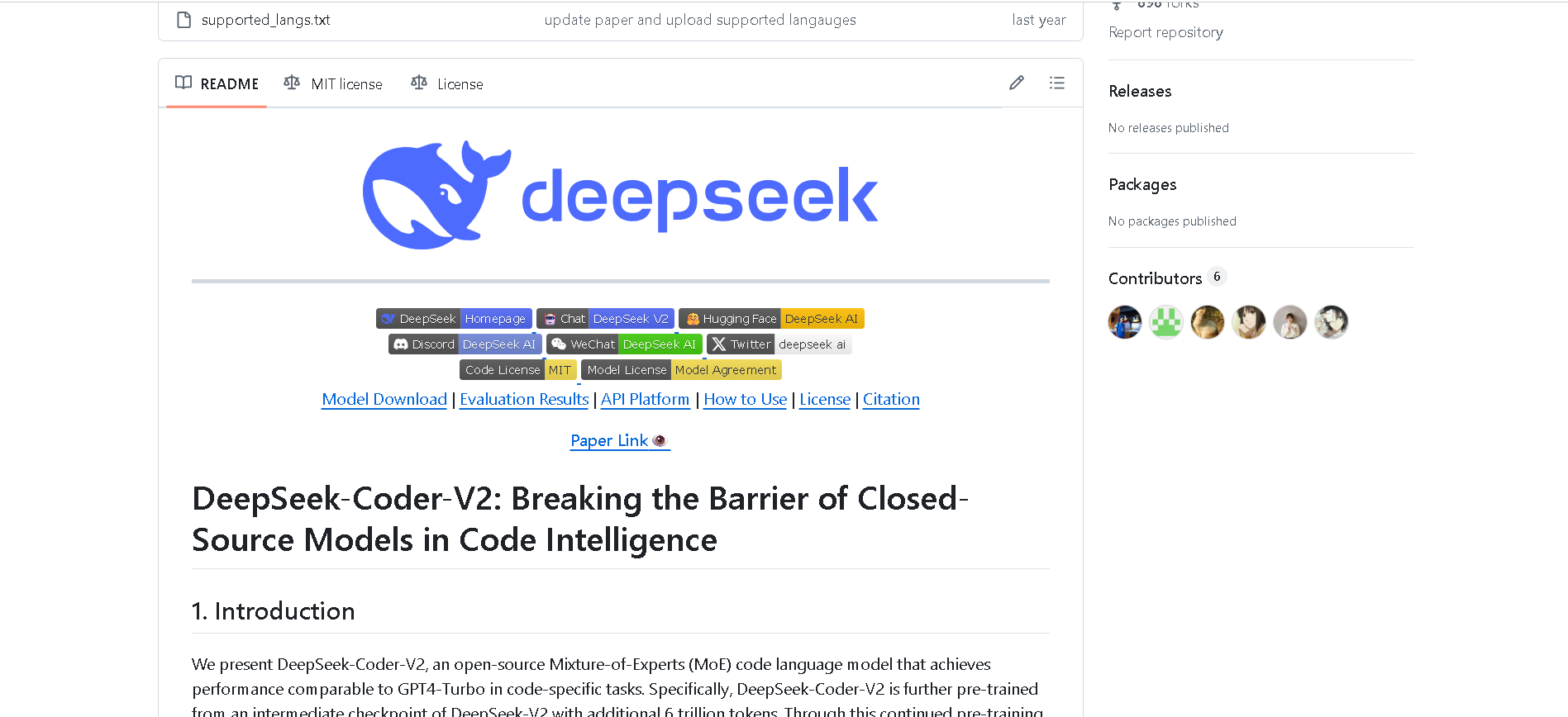

DeepSeek-Coder-V2
DeepSeek‑Coder V2 is an open-source, Mixture‑of‑Experts (MoE) code-focused variant of DeepSeek‑V2, purpose-built for code generation, completion, debugging, and mathematical reasoning. Trained with an additional 6 trillion tokens of code and text, it supports up to 338 programming languages and a massive 128K‑token context window, rivaling or exceeding commercial code models in performance.


DeepSeek-Coder-V2
DeepSeek‑Coder V2 is an open-source, Mixture‑of‑Experts (MoE) code-focused variant of DeepSeek‑V2, purpose-built for code generation, completion, debugging, and mathematical reasoning. Trained with an additional 6 trillion tokens of code and text, it supports up to 338 programming languages and a massive 128K‑token context window, rivaling or exceeding commercial code models in performance.


DeepSeek-Coder-V2
DeepSeek‑Coder V2 is an open-source, Mixture‑of‑Experts (MoE) code-focused variant of DeepSeek‑V2, purpose-built for code generation, completion, debugging, and mathematical reasoning. Trained with an additional 6 trillion tokens of code and text, it supports up to 338 programming languages and a massive 128K‑token context window, rivaling or exceeding commercial code models in performance.
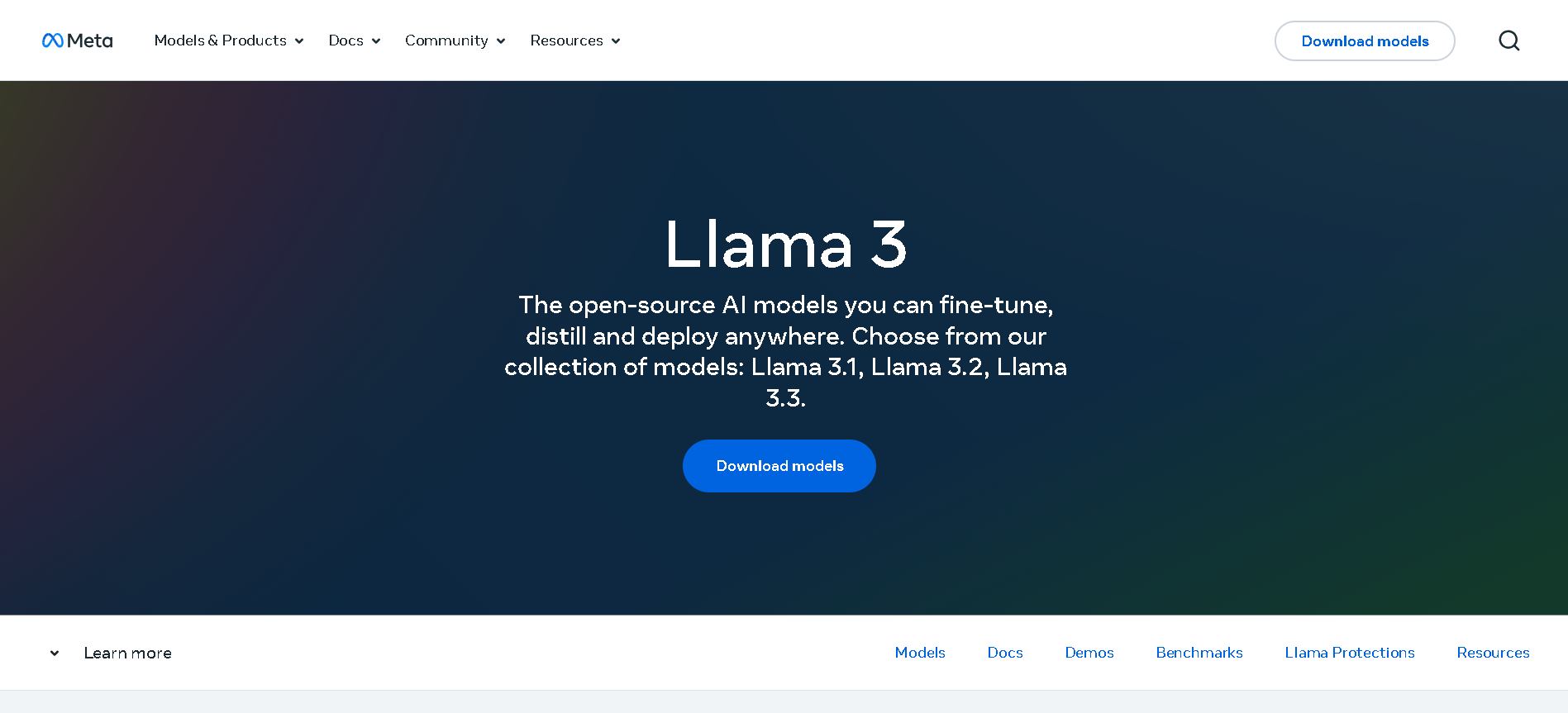

Meta Llama 3.2
Llama 3.2 is Meta’s multimodal and lightweight update to its Llama 3 line, released on September 25, 2024. The family includes 1B and 3B text-only models optimized for edge devices, as well as 11B and 90B Vision models capable of image understanding. It offers a 128K-token context window, Grouped-Query Attention for efficient inference, and opens up on-device, private AI with strong multilingual (e.g. Hindi, Spanish) support.


Meta Llama 3.2
Llama 3.2 is Meta’s multimodal and lightweight update to its Llama 3 line, released on September 25, 2024. The family includes 1B and 3B text-only models optimized for edge devices, as well as 11B and 90B Vision models capable of image understanding. It offers a 128K-token context window, Grouped-Query Attention for efficient inference, and opens up on-device, private AI with strong multilingual (e.g. Hindi, Spanish) support.


Meta Llama 3.2
Llama 3.2 is Meta’s multimodal and lightweight update to its Llama 3 line, released on September 25, 2024. The family includes 1B and 3B text-only models optimized for edge devices, as well as 11B and 90B Vision models capable of image understanding. It offers a 128K-token context window, Grouped-Query Attention for efficient inference, and opens up on-device, private AI with strong multilingual (e.g. Hindi, Spanish) support.
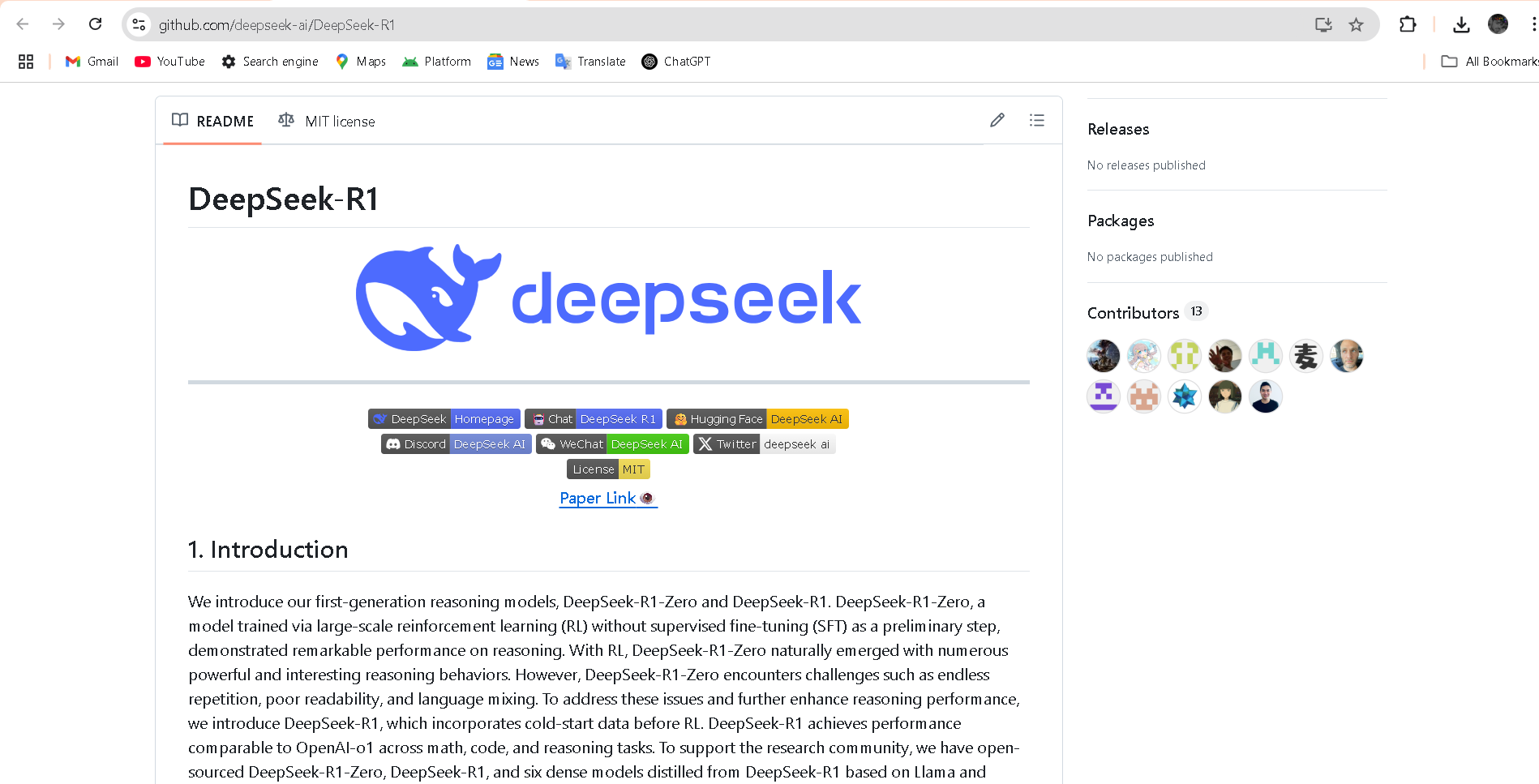

DeepSeek-R1-Distil..
DeepSeek R1 Distill refers to a family of dense, smaller models distilled from DeepSeek’s flagship DeepSeek R1 reasoning model. Released early 2025, these models come in sizes ranging from 1.5B to 70B parameters (e.g., DeepSeek‑R1‑Distill‑Qwen‑32B) and retain powerful reasoning and chain-of-thought abilities in a more efficient architecture. Benchmarks show distilled variants outperform models like OpenAI’s o1‑mini, while remaining open‑source under MIT license.


DeepSeek-R1-Distil..
DeepSeek R1 Distill refers to a family of dense, smaller models distilled from DeepSeek’s flagship DeepSeek R1 reasoning model. Released early 2025, these models come in sizes ranging from 1.5B to 70B parameters (e.g., DeepSeek‑R1‑Distill‑Qwen‑32B) and retain powerful reasoning and chain-of-thought abilities in a more efficient architecture. Benchmarks show distilled variants outperform models like OpenAI’s o1‑mini, while remaining open‑source under MIT license.


DeepSeek-R1-Distil..
DeepSeek R1 Distill refers to a family of dense, smaller models distilled from DeepSeek’s flagship DeepSeek R1 reasoning model. Released early 2025, these models come in sizes ranging from 1.5B to 70B parameters (e.g., DeepSeek‑R1‑Distill‑Qwen‑32B) and retain powerful reasoning and chain-of-thought abilities in a more efficient architecture. Benchmarks show distilled variants outperform models like OpenAI’s o1‑mini, while remaining open‑source under MIT license.
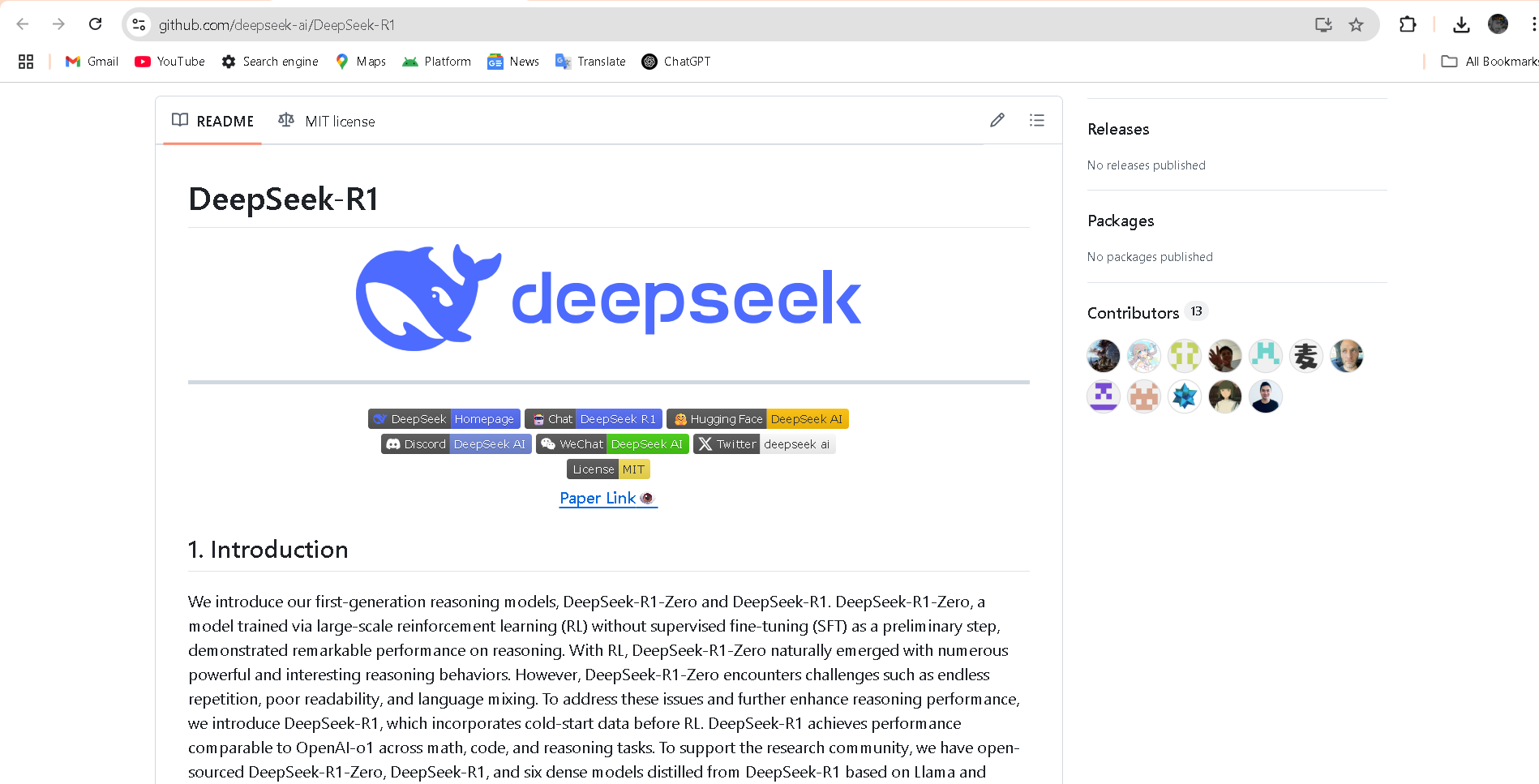

DeepSeek-R1-Distil..
DeepSeek R1 Distill Qwen‑32B is a 32-billion-parameter dense reasoning model released in early 2025. Distilled from the flagship DeepSeek R1 using Qwen 2.5‑32B as a base, it delivers state-of-the-art performance among dense LLMs—outperforming OpenAI’s o1‑mini on benchmarks like AIME, MATH‑500, GPQA Diamond, LiveCodeBench, and CodeForces rating.


DeepSeek-R1-Distil..
DeepSeek R1 Distill Qwen‑32B is a 32-billion-parameter dense reasoning model released in early 2025. Distilled from the flagship DeepSeek R1 using Qwen 2.5‑32B as a base, it delivers state-of-the-art performance among dense LLMs—outperforming OpenAI’s o1‑mini on benchmarks like AIME, MATH‑500, GPQA Diamond, LiveCodeBench, and CodeForces rating.


DeepSeek-R1-Distil..
DeepSeek R1 Distill Qwen‑32B is a 32-billion-parameter dense reasoning model released in early 2025. Distilled from the flagship DeepSeek R1 using Qwen 2.5‑32B as a base, it delivers state-of-the-art performance among dense LLMs—outperforming OpenAI’s o1‑mini on benchmarks like AIME, MATH‑500, GPQA Diamond, LiveCodeBench, and CodeForces rating.
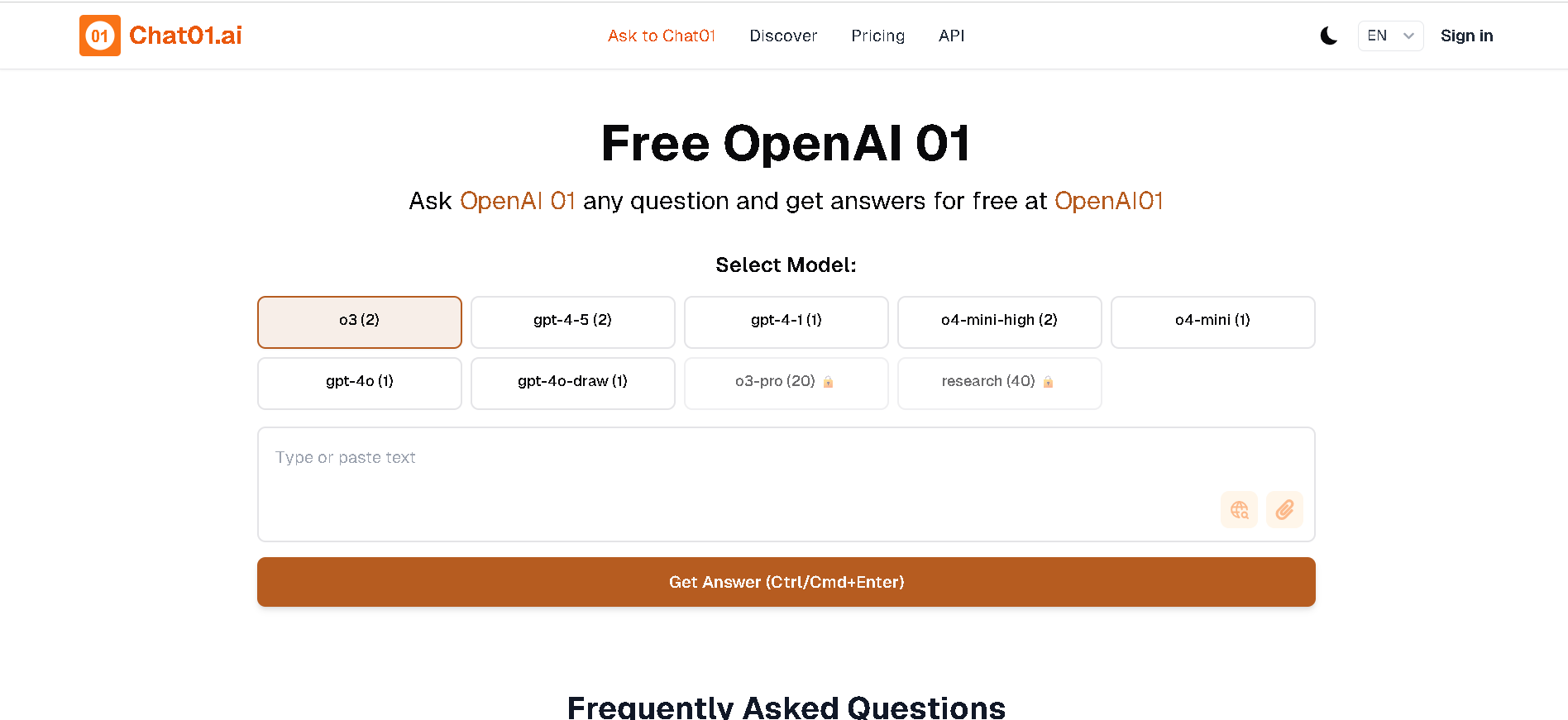
Chat 01 AI
Chat01.ai is a platform that offers free and unlimited chat with OpenAI 01, a new series of AI models. These models are specifically designed for complex reasoning and problem-solving in areas such as science, coding, and math, by employing a "think more before responding" approach, trying different strategies, and recognizing mistakes.

Chat 01 AI
Chat01.ai is a platform that offers free and unlimited chat with OpenAI 01, a new series of AI models. These models are specifically designed for complex reasoning and problem-solving in areas such as science, coding, and math, by employing a "think more before responding" approach, trying different strategies, and recognizing mistakes.

Chat 01 AI
Chat01.ai is a platform that offers free and unlimited chat with OpenAI 01, a new series of AI models. These models are specifically designed for complex reasoning and problem-solving in areas such as science, coding, and math, by employing a "think more before responding" approach, trying different strategies, and recognizing mistakes.
Editorial Note
This page was researched and written by the ATB Editorial Team. Our team researches each AI tool by reviewing its official website, testing features, exploring real use cases, and considering user feedback. Every page is fact-checked and regularly updated to ensure the information stays accurate, neutral, and useful for our readers.
If you have any suggestions or questions, email us at hello@aitoolbook.ai
